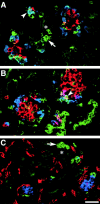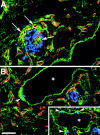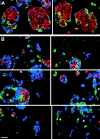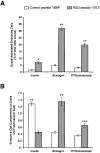Expression and function of alpha(v)beta(3) and alpha(v)beta(5) integrins in the developing pancreas: roles in the adhesion and migration of putative endocrine progenitor cells
- PMID: 10995448
- PMCID: PMC2150716
- DOI: 10.1083/jcb.150.6.1445
Expression and function of alpha(v)beta(3) and alpha(v)beta(5) integrins in the developing pancreas: roles in the adhesion and migration of putative endocrine progenitor cells
Abstract
Cell-cell and cell-matrix interactions play a critical role in tissue morphogenesis and in homeostasis of adult tissues. The integrin family of adhesion receptors regulates cellular interactions with the extracellular matrix, which provides three-dimensional information for tissue organization. It is currently thought that pancreatic islet cells develop from undifferentiated progenitors residing within the ductal epithelium of the fetal pancreas. This process involves cell budding from the duct, migration into the surrounding mesenchyme, differentiation, and clustering into the highly organized islet of Langerhans. Here we report that alpha(v)beta(3) and alpha(v)beta(5), two integrins known to coordinate epithelial cell adhesion and movement, are expressed in pancreatic ductal cells and clusters of undifferentiated cells emerging from the ductal epithelium. We show that expression and function of alpha(v)beta(3) and alpha(v)beta(5) integrins are developmentally regulated during pancreatic islet ontogeny, and mediate adhesion and migration of putative endocrine progenitor cells both in vitro and in vivo in a model of pancreatic islet development. Moreover, we demonstrate the expression of fibronectin and collagen IV in the basal membrane of pancreatic ducts and of cell clusters budding from the ductal epithelium. Conversely, expression of vitronectin marks a population of epithelial cells adjacent to, or emerging from, pancreatic ducts. Thus, these data provide the first evidence for the contribution of integrins alpha(v)beta(3) and alpha(v)beta(5) and their ligands to morphogenetic events in the human endocrine pancreas.
Figures













Similar articles
-
KSA antigen Ep-CAM mediates cell-cell adhesion of pancreatic epithelial cells: morphoregulatory roles in pancreatic islet development.J Cell Biol. 1998 Mar 23;140(6):1519-34. doi: 10.1083/jcb.140.6.1519. J Cell Biol. 1998. PMID: 9508783 Free PMC article.
-
In vivo cell transformation: neogenesis of beta cells from pancreatic ductal cells.Cell Transplant. 1995 Jul-Aug;4(4):371-83. doi: 10.1177/096368979500400408. Cell Transplant. 1995. PMID: 7582568 Review.
-
Multipotential nestin-positive stem cells isolated from adult pancreatic islets differentiate ex vivo into pancreatic endocrine, exocrine, and hepatic phenotypes.Diabetes. 2001 Mar;50(3):521-33. doi: 10.2337/diabetes.50.3.521. Diabetes. 2001. PMID: 11246871
-
Netrin-1 expression in fetal and regenerating rat pancreas and its effect on the migration of human pancreatic duct and porcine islet precursor cells.Diabetologia. 2003 Jul;46(7):926-33. doi: 10.1007/s00125-003-1125-5. Epub 2003 Jun 18. Diabetologia. 2003. PMID: 12819897
-
Can pancreatic duct-derived progenitors be a source of islet regeneration?Biochem Biophys Res Commun. 2009 Jun 12;383(4):383-5. doi: 10.1016/j.bbrc.2009.03.114. Epub 2009 Mar 24. Biochem Biophys Res Commun. 2009. PMID: 19324022 Review.
Cited by
-
The stromal cell-derived factor-1alpha/CXCR4 ligand-receptor axis is critical for progenitor survival and migration in the pancreas.J Cell Biol. 2003 Nov 24;163(4):859-69. doi: 10.1083/jcb.200304153. J Cell Biol. 2003. PMID: 14638861 Free PMC article.
-
Extracellular matrix molecules and their potential contribution to the function of transplanted pancreatic islets.Diabetologia. 2018 Jun;61(6):1261-1272. doi: 10.1007/s00125-017-4524-8. Epub 2018 Jan 6. Diabetologia. 2018. PMID: 29306997 Free PMC article. Review.
-
Recombinant disintegrin (r-Cam-dis) from Crotalus adamanteus inhibits adhesion of human pancreatic cancer cell lines to laminin-1 and vitronectin.J Venom Res. 2015 Apr 26;6:1-10. eCollection 2015. J Venom Res. 2015. PMID: 26045944 Free PMC article.
-
Tissue engineering approaches to cell-based type 1 diabetes therapy.Tissue Eng Part B Rev. 2014 Oct;20(5):455-67. doi: 10.1089/ten.TEB.2013.0462. Epub 2014 Apr 22. Tissue Eng Part B Rev. 2014. PMID: 24417705 Free PMC article. Review.
-
A novel method of pancreatic islet transplantation at the liver surface using a gelatin hydrogel nonwoven fabric.Cell Transplant. 2025 Jan-Dec;34:9636897251328419. doi: 10.1177/09636897251328419. Epub 2025 Apr 23. Cell Transplant. 2025. PMID: 40264358 Free PMC article.
References
-
- Alpert S., Hanahan D., Tietelman G. Hybrid insulin gene reveal a developmental lineage for pancreatic endocrine cell and imply a relationship with neurons. Cell. 1988;53:295–308. - PubMed
-
- Bauer G.E., Balsamo J., Lilien J. Cadherin-mediated adhesion in pancreatic islet cells is modulated by a cell surface N-acetylgalactosaminylphosphotransferase. J. Cell Sci. 1992;103:1235–1241. - PubMed
-
- Beattie G.M., Levine F., Mally M.I., Otonkoski T., O'Brien J.S., Salomon D.R., Hayek A. Acid β-galactosidasea developmentally regulated marker of endocrine cell precursors in the human fetal pancreas. J. Clin. Endocrinol. Metab. 1994;78:1232–1240. - PubMed
-
- Beattie G.M., Rubin J.S., Mally M.I., Otonkoski T., Hayek A. Regulation of proliferation and differentiation of human fetal pancreatic islet cells by extracellular matrix, hepatocyte growth factor and cell-cell contact. Diabetes. 1996;45:1223–1228. - PubMed
-
- Beattie G.M., Cirulli V., Lopez A.D., Hayek A. Ex vivo expansion of human pancreatic endocrine cells. J. Clin. Endocrinol. Metab. 1997;82:1852–1856. - PubMed
Publication types
MeSH terms
Substances
Grants and funding
LinkOut - more resources
Full Text Sources
Other Literature Sources
Medical

